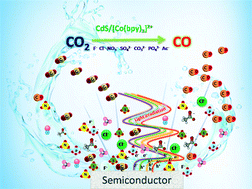The influence of inorganic anions on photocatalytic CO2 reduction†
Abstract
The influence of common inorganic anions on photocatalytic CO2 reduction has been investigated in a semiconductor/complex (CdS/Co(bpy)3Cl2) system. There were significant differences in photocatalytic performance when the reactions occurred in media with various inorganic anions. These results demonstrated that inorganic anions affect the photoreduction of CO2 through their redox performance, capacity to coordinate with metal cations, and so on. Some inorganic anions, such as NO3−, H2PO4−, CO32−, CH3COO−, and SO42− showed different degrees of inhibition on the photocatalytic reduction of CO2, particularly at high concentrations. No significant effect on the catalytic performance was observed at the same concentration of Cl−. On the contrary, F− and a low concentration of CO32− exhibited a promotion effect on CO evolution. In this paper, the photochemical observations reveal the relationship between inorganic anions and photocatalytic CO2 reduction performance. Electrochemical/spectrographic measurements suggest possible influencing mechanisms by these anions for CO2 reduction, which may provide useful information for experimental design and new considerations for addressing highly efficient artificial synthesis.

- This article is part of the themed collection: 2020 Catalysis Science & Technology Hot Articles


 Please wait while we load your content...
Please wait while we load your content...